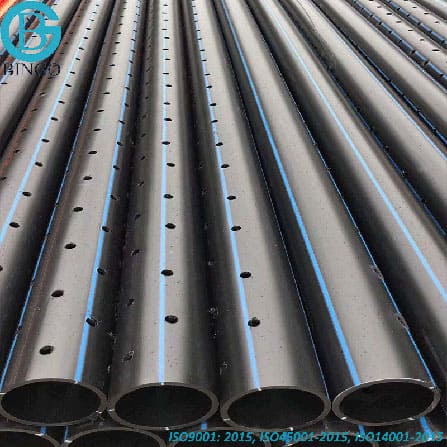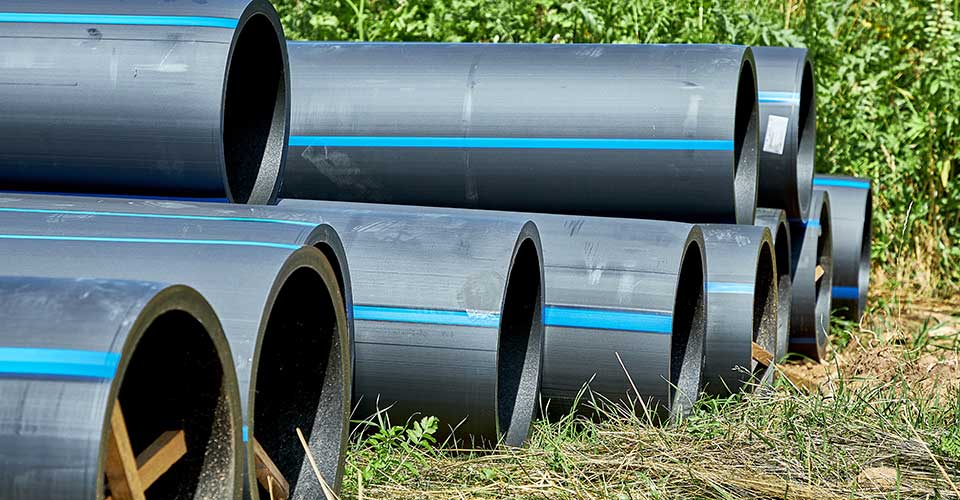How hdpe pipe suppliers Midland TX Are Enhancing Agriculture
Discover the Manufacturing Refine Behind High-Quality HDPE Pipeline and Its Applications
The manufacturing procedure of premium HDPE pipelines is elaborate and methodical. It begins with the choice of resources that improve performance. Following this, ethylene goes through polymerization to develop material, which is then formed via extrusion. Quality assurance is critical, making certain that the end product satisfies stringent criteria. Nevertheless, the trip of HDPE pipelines doesn't end with production. Their applications across different sectors expose a more comprehensive significance worth examining.
Recognizing HDPE: Features and Advantages

High-density polyethylene (HDPE) is a versatile thermoplastic understood for its toughness and resistance to numerous ecological aspects. This product shows superb tensile strength, making it suitable for demanding applications. Its low-density structure adds to a lightweight product, helping with simplicity of handling and installment. HDPE likewise showcases impressive resistance to chemicals, which decreases degradation when revealed to extreme compounds.
The product's reduced wetness absorption even more boosts its longevity, making it optimal for use in pipes and storage space tanks. Additionally, HDPE is immune to ultraviolet (UV) radiation, making sure that items maintain their integrity also when exposed to sunlight. Its flexibility allows for the production of intricate forms without compromising strength. The environmentally friendly nature of HDPE, typically originated from recycled products, includes in its appeal, promoting lasting practices in manufacturing. On the whole, these buildings and benefits make HDPE a recommended selection for numerous commercial and customer applications.
Resources Option for HDPE Production
The selection of basic materials for HDPE manufacturing is important to validate the last item satisfies the desired specifications and top quality criteria. High-density polyethylene (HDPE) is largely created from polymerized ethylene, stemmed from fossil gas such as gas or petroleum. The high quality of these feedstocks substantially affects the mechanical and thermal residential or commercial properties of the final HDPE.
Ingredients likewise play a considerable duty in improving HDPE's efficiency, consisting of anti-oxidants, UV stabilizers, and colorants, which boost durability and resistance to ecological variables. The option procedure should think about not only the chemical structure of the raw products yet also their processing characteristics to guarantee reliable manufacturing.
The sourcing of raw products ought to focus on sustainability and compliance with environmental regulations, as liable techniques are important in today's market. Inevitably, careful resources selection lays the structure for generating top quality HDPE pipes appropriate for varied applications.
The Extrusion Process: Shaping HDPE Pipeline
The extrusion process plays an important duty in shaping HDPE pipelines, starting with careful material preparation methods that assure excellent flow and uniformity. Just as essential is the design of the die, which directly influences the final measurements and surface area top quality of the pipeline. With each other, these variables add greatly to the efficiency and high quality of HDPE pipeline production.
Material Prep Work Methods
Efficient production of HDPE pipes starts with precise product prep work strategies, particularly the extrusion process. Throughout this phase, high-density polyethylene resin is initial dried to get rid of wetness, guaranteeing excellent circulation qualities. The material is after that fed into the extruder, where it goes through home heating and melting, transforming right into a thick state. This heating process is thoroughly regulated to preserve the product's honesty and efficiency. The liquified HDPE is required with a die, forming it right into a continuous pipeline kind. Appropriate temperature administration throughout extrusion is important, as it straight affects the material's residential or commercial properties and the end product top quality. As soon as formed, the HDPE pipeline is cooled down and reduced to specified lengths, prepared for subsequent processing and applications.
Die Layout Significance
Precision in die design plays an essential function in the extrusion procedure of HDPE pipelines. The die functions as the last shaping device, directly influencing the pipe's measurements, wall surface density, and surface area coating. A properly designed die guarantees consistent product circulation, minimizing problems such as irregularities and vulnerable points. The geometry of the die should be optimized to accommodate the details properties of HDPE, including its viscosity and thermal habits throughout extrusion. In addition, the cooling rate of the material as it travels through the die can substantially affect the pipe's architectural stability. Investing in sophisticated die innovation is important for producers intending to generate high-grade HDPE pipes that satisfy market standards and client assumptions.
Quality Assurance Steps in HDPE Production
Various elements affect the high quality of HDPE pipeline production, effective top quality control steps are essential to guarantee uniformity and reliability in the final product (American Plastics HDPE Pipe Manufacturing). Trick quality assurance practices include extensive material assessment, confirming that the raw polyethylene satisfies well established standards for purity and density. During the extrusion process, specifications such as temperature level, pressure, and cooling time are very closely checked to maintain dimensional precision and structural honesty
On top of that, post-production testing is important; producers commonly carry out hydrostatic examinations to examine the pipe's toughness and resistance to stress. Visual inspections for surface area problems better improve quality control. Certification from appropriate criteria companies, like ASTM or ISO, provides an additional layer of trustworthiness. By applying these extensive quality assurance steps, suppliers can minimize defects, boost performance, and guarantee that the HDPE pipelines fulfill the details needs of different applications, ultimately resulting in consumer complete satisfaction and count on the item.
Applications of HDPE Pipeline Across Industries
HDPE pipelines are made use of throughout different markets as a result of their longevity and convenience. In water distribution systems, they guarantee efficient delivery, while in wastewater management, they supply trusted remedies for waste transport. Furthermore, agricultural watering networks profit from HDPE's resistance to corrosion and adaptability, making it a perfect selection for contemporary farming methods.

Water Circulation Equipments
A substantial variety of markets depend on high-density polyethylene (HDPE) pipes for effective water distribution systems. Recognized for their durability and resistance to rust, HDPE pipelines are widely made use of in local water supply networks, farming watering, and industrial applications. Their lightweight nature promotes easy handling and setup, reducing labor prices and time. Furthermore, HDPE pipes can fit different stress degrees, making them suitable for both reduced and high-pressure systems. hdpe pipe suppliers Midland TX. The adaptability of the product enables for smooth assimilation into existing infrastructure, decreasing the demand for substantial excavation. HDPE's resistance to chemical seeping guarantees that the water provided continues to be secure and clean, making it an optimal choice for maintaining the top quality of safe and clean water across various sectors.
Wastewater Monitoring Solutions
Effective water circulation systems likewise lead the way for ingenious wastewater monitoring remedies, where high-density polyethylene (HDPE) pipes play a considerable duty. Distinguished for their durability and resistance to corrosion, HDPE pipelines are suitable for delivering wastewater in numerous settings. Their flexibility enables for very easy installment in complicated environments, decreasing the requirement for comprehensive excavation. Additionally, HDPE's smooth interior surface area minimizes rubbing, enhancing circulation prices and efficiency. These pipes are also immune to chemical leaching, making certain that contaminants do not jeopardize the surrounding environment. Industries, municipalities, and therapy facilities increasingly depend on read more HDPE pipes for their dependability and durability, making them a recommended option for modern-day wastewater administration systems. This versatility highlights the important importance of HDPE pipelines throughout countless applications.
Agricultural Watering Networks
Agricultural irrigation networks profit significantly from the usage of high-density polyethylene (HDPE) pipelines, which offer effective and reputable water shipment to crops. HDPE pipelines are light-weight, making them simple to transport and install, while their flexibility permits various configurations in varied terrains. These pipelines demonstrate superb resistance to corrosion, chemicals, and UV radiation, making sure durability in extreme farming environments. Additionally, their smooth indoor surface area decreases friction loss, enhancing water flow and reducing power expenses related to pumping. The long life of HDPE pipelines, commonly exceeding 50 years, contributes to reduce maintenance and replacement expenses. Subsequently, farmers progressively depend on HDPE pipelines to boost irrigation efficiency and promote lasting agricultural methods, ultimately bring about enhanced crop returns and source conservation.
Future Trends in HDPE Pipeline Innovation
As the demand for sustainable and reliable infrastructure expands, innovations in HDPE pipeline innovation are positioned to change different sectors. Emerging trends consist of the integration of wise technologies, such as sensors and IoT capabilities, which assist in real-time tracking of pipe problems, decreasing maintenance costs and stopping leaks. In addition, the growth of advanced production methods, such as 3D printing, is allowing the manufacturing of complex, personalized pipe layouts that accommodate certain project demands.
Moreover, the concentrate on recycling and circular economic situation practices is driving the innovation of HDPE pipelines made from recycled products, boosting sustainability. Boosted jointing techniques, such as electro-fusion and mechanical installations, are additionally improving installment effectiveness and dependability. Ultimately, the expanding focus on environmental policies is pressing suppliers to take on greener production procedures, guaranteeing that HDPE pipelines not just fulfill industry criteria yet likewise promote an even more lasting future for infrastructure development.
Regularly Asked Concerns
Exactly How Does HDPE Contrast to Various Other Plastic Materials?
HDPE outperforms lots of various other plastic products concerning longevity, chemical resistance, and flexibility. Its reduced density and high tensile strength make it suitable for different applications, usually going beyond choices in both performance and long life.
What Are the Ecological Influences of HDPE Manufacturing?
The environmental effects of HDPE production consist of greenhouse gas discharges, power usage, and prospective pollution from making processes. In addition, inappropriate disposal can result in dirt and water contamination, raising problems concerning long-lasting eco-friendly results.
Can HDPE Piping Be Recycled?
Yes, HDPE pipelines can be recycled. Numerous centers approve made use of HDPE for processing, changing it right into new products. This recycling adds to sustainability initiatives, decreasing plastic waste while conserving resources and energy in the manufacturing cycle.
What Is the Life-span of HDPE Pipes?

How Do Temperature Variants Influence HDPE Pipe Efficiency?
Temperature variations greatly affect HDPE pipeline performance, impacting versatility and stamina. Heats can bring about softening, while reduced temperature levels might trigger brittleness, inevitably affecting the pipeline's durability and viability for various applications in varied environments.